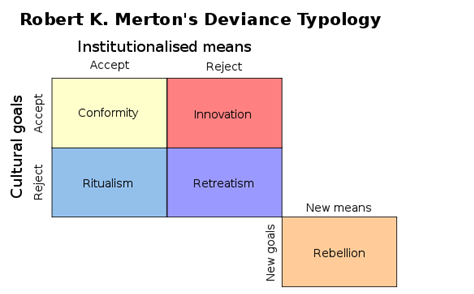Introduction
Deviance in a sociological context describes actions or behaviors that violate cultural norms including formally-enacted rules (e.g., crime) as well as informal violations of social norms (e.g., rejecting folkways and mores). It is the purview of sociologists, psychologists, psychiatrists, and criminologists to study how these norms are created, how they change over time and how they are enforced
Norms are the specific behavioral standards, ways in which people are supposed to act, paradigms for predictable behavior in society. They are not necessarily moral, or even grounded in morality; in fact, they are just as often pragmatic and, paradoxically, irrational. (A great many of what we call manners, having no logical grounds, would make for good examples here.) Norms are rules of conduct, not neutral or universal, but ever changing; shifting as society shifts; mutable, emergent, loose, reflective of inherent biases and interests, and highly selfish and one-sided. They vary from class to class, and in the generational “gap.” They are, in other words, contextual Deviance can be described as a violation of these norms. Deviance is a failure to conform to culturally reinforced norms. This definition can be interpreted in many different ways. Social norms are different in one culture as opposed to another.
Theories of deviance/ criminology
There are four theories about deviance are following-
- Functionalist theory
- Interactionist theory
- Conflict theory
- Control theory
Functionalist theory
Social integration is the attachment to groups and institutions, while social regulation is the adherence to the norms and values of the society. Those who are very integrated fall under the category of “altruism” and those who are very unintegrated fall under “egoism.” Similarly, those who are very regulated fall under “fatalism” and those who are very unregulated fall under “ano Social integration is the attachment to groups and institutions, while social regulation is the adherence to the norms and values of the society. Those who are very integrated fall under the category of “altruism” and those who are very unintegrated fall under “egoism.” Similarly, those who are very regulated fall under “fatalism” and those who are very unregulated fall under “anomie”. Durkheim’s strain theory attributes social deviance to extremes of the dimensions of the social bond. Altruistic suicide (death for the good of the group), egoistic suicide (death for the removal of the self due to or justified by the lack of ties to others), and anomic suicide (death due to the confounding of self-interest and societal norms) are the three forms of suicide that can happen due to extremes. Likewise, individuals may commit crimes for the good of an individual’s group, for the self due to or justified by lack of ties, or because the societal norms that place the individual in check no longer have power due to society’s corruption.mie”. Durkheim’s strain theory attributes social deviance to extremes of the dimensions of the social bond. Altruistic suicide (death for the good of the group), egoistic suicide (death for the removal of the self due to or justified by the lack of ties to others), and anomic suicide (death due to the confounding of self-interest and societal norms) are the three forms of suicide that can happen due to extremes. Likewise, individuals may commit crimes for the good of an individual’s group, for the self due to or justified by lack of ties, or because the societal norms that place the individual in check no longer have power due to society’s corruption.
Three sociologist views about Functionalist theory
v Emile Durkheim
v Robert Merton
v Albert Cohen
Emile Durkheim ideas on deviance:
- “Anomie” leads to deviance. Anomie exists when there are no social standards to guide behavior in a particular area of social life.
- Emile Durkheim viewed deviance on “social facts” which is inevitable. People in modern society enjoy more freedom compared to people in traditional society. As a result, deviance is essential to occur. Deviance will be there, but its limit kept at an acceptable level.
- Durkheim believes deviance is necessary society. For 2 reason-
a) He thinks deviance is an “innovative force”. Through deviance new rule & changes are brought which sometimes appear beneficial for the society in long run.
b) Deviance draws a boundary between “good” & “bad”.
Robert Merton’s ideas on deviance:
- “Anomie” leads to deviance. Anomie exists when there is conflict between social norms & socially accepted means to achieve those. As a result, of this conflict the unsuccessful person who failed to achieve the norms refers to any means, be it illegitimate to achieve those.
Merton divided people in a society five claws-

a) Conformist: – These people accept both the social norms & the means to realize those. Majority people follow in this category.
b) Innovators: – They accept the social norms but they do not follow socially accepted means to realize those norms.
c) Ritualists: – They accept the social norms but without realizing the real meaning of the norms. They follow the norms like rituals; they follow these just for the sake of following.
d) Retreatists: – They do not accept both the social norms & socially accepted means to achieve those norms. They have given up of the social system.
e) Rebels: – The rebels work to replace the social norms & means by the new ones.
Albert Cohen ideas on deviance:
- Deviance emerges from subcultures.
- The subcultures have limited access to researches than the people of mainstream culture. It creates a sense of deprivation in them which leads to deviance.
Criticism of functionalist theory
The primary contribution of anomie theory is its ability to explain many forms of deviance. The theory is also sociological in its emphasis on the role of social forces in creating deviance. On the negative side, anomie theory has been criticized for its generality. Critics note the theory’s lack of statements concerning the process of learning deviance, including the internal motivators for deviance. Like differential association theory, anomie theory does not lend itself to precise scientific study.
Interactionist theory
- Deviance is “learned”. People learn it through interaction with deviant people. Edwin Sutherland has called this phenomenon differential association.
Labeling theory is the part of interectionist theory.
Labeling theory
- Powerful section of the society creates law to protect their privileged position & they create some institutions such as, court, police etc. To interpret & implement these laws.
- The artificial mechanism creates by the ruling class is labeling the working class of the society as “deviant” people.
- No act is intrinsically deviant or criminal. We label certain people doing an act as “deviant” depending on which social class he/she belongs to & also depending on the immediate reality.
- There are two types of deviance
I. Primary deviance- First crime committed by a person.
II. Secondary deviance- If first crime is handled in a way that involves giving strong punishment, propensity to commit crime increases.
Criticism of Labeling Theory
Proponents of labeling theory support the theory’s emphasis on the role that the attitudes and reactions of others, not deviant acts per se, have on the development of deviance. Critics of labeling theory indicate that the theory only applies to a small number of deviants, because such people are actually caught and labeled as deviants. Critics also argue that the concepts in the theory are unclear and thus difficult to test scientifically.
Conflict theory
- It is offered by sociologists who uphold Marxist view.
- Class struggle between “rich” & “poor” in capitalist society, drag the poor towards deviance & crime.
Criticism of conflict theory
Conflict Criminologies have come under sustained attack from several quarters, not least from those – left realists – who claim to be within the ranks. Early criminologies, pejoratively referred to as ‘left idealist’ by Jock Young 1979, were never really popular in the United States, where critical criminology departments at some universities were closed for political reasons (Rock 1997). These early criminologies were called into question by the introduction of mass self report victim surveys (Hough & Mayhew 1983) that showed that victimisation was intra-class rather than inter-class. Thus notions that crimes like robbery were somehow primitive forms of wealth redistribution were shown to be false. Further attacks emanated from feminists who maintained that the victimisation of women was no mean business and that left idealists’ concentration on the crimes of the working classes that could be seen as politically motivated ignored crimes such as rape, domestic violence, or child abuse (Smart 1977). Furthermore, it was claimed, left idealists neglected the comparative aspect of the study of crime, in that they ignored the significant quantities of crime in socialist societies, and ignored the low crime levels in capitalist societies like Switzerland and Japan (Incardi 1980).
Control theory
- Deviance/crime take place due to lack of “control” on human impulse to take advantage of “opportunity”.
- Travis hirew sug’s human beings are selfish and take calculative decisions. We do “cost benefit analysis” before getting involved in an action.
People get involved in crime to get advantage of opportunities.
- Human impulse instinct to take advantage of opportunities has to be controlled to reduce crime control theorists believe that in modern society number of opportunities is increasing day by day. In- TV, refrige, AC and so on. Homes remain empty during day time is more women work outside home now-a-days there opportunities are “targets “for criminals.
- According to control theorists the control on targets. Should be tightened to reduce crime, which they have termed as “target hardening”. In- security, watch dog etc.
- The criticism of control theory talks about its inability to find out the red reason behind crime. It gives all emphasis on “target” of crime. Besides, target hardening is unlikely to reduce crime since criminal will shift their attention from tightly controlled target to loosely control ones.
Criticism of control theory
Whereas theory also suggests that people society labels as “criminals” are probably members of subordinate groups, critics argue that this oversimplifies the situation. As examples, they cite wealthy and powerful businesspeople, politicians, and others who commit crimes. Critics also argue that conflict theory does little to explain the causes of deviance. Proponents counter, however, by asserting that the theory does not attempt to delve into etiologies. Instead, the theory does what it claims to do: It discusses the relationships between socialization, social controls, and behavior.
Conclusion
Deviance is any behavior that violates social norms, and is usually of sufficient severity to warrant disapproval from the majority of society. Deviance can be criminal or non-criminal. The sociological discipline that deals with crime (behavior that violates laws) is criminology (also known as criminal justice). Today, Americans consider such activities as alcoholism, excessive gambling, being nude in public places, playing with fire, stealing, lying, refusing to bathe, purchasing the services of prostitutes, and cross-dressing—to name only a few—as deviant. People who engage in deviant behavior are referred to as deviants. The concept of deviance is complex because norms vary considerably across groups, times, and places
Collected and Published by Assignment Point.
















